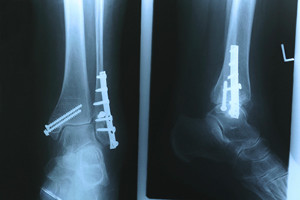 Ankle fractures can vary from hairline cracks to shattered bones. Depending upon the nature and severity of the injury, a full recovery may take months. As experts in ankle and foot health, a podiatrist can diagnose and treat your ankle fracture with a specific treatment plan—and there are things you can do to aid the healing process while keeping yourself safe. Keep a list of any medications that have been prescribed to you, always take them as directed, and check with your doctor first before taking any over-the-counter medicine. To reduce swelling, use pillows to elevate your leg above your heart, and see if your doctor thinks moving your toes around may help. If you are wearing a cast or splint, keep it dry and never try to remove it yourself. If your toes become numb, you experience new or worsening pain, or your foot changes color, call your podiatrist immediately. Working with your podiatrist will help you get back on your feet as quickly and safely as possible.
Ankle fractures can vary from hairline cracks to shattered bones. Depending upon the nature and severity of the injury, a full recovery may take months. As experts in ankle and foot health, a podiatrist can diagnose and treat your ankle fracture with a specific treatment plan—and there are things you can do to aid the healing process while keeping yourself safe. Keep a list of any medications that have been prescribed to you, always take them as directed, and check with your doctor first before taking any over-the-counter medicine. To reduce swelling, use pillows to elevate your leg above your heart, and see if your doctor thinks moving your toes around may help. If you are wearing a cast or splint, keep it dry and never try to remove it yourself. If your toes become numb, you experience new or worsening pain, or your foot changes color, call your podiatrist immediately. Working with your podiatrist will help you get back on your feet as quickly and safely as possible.
Foot and ankle trauma is common among athletes and the elderly. If you have concerns that you may have experienced trauma to the foot and ankle, consult with Mark Hupart, DPM from Southside Podiatry . Our doctor will assess your condition and provide you with quality foot and ankle treatment.
Foot and ankle trauma cover a range of injuries all over the foot; common injuries include:
- Broken bones
- Muscle strains
- Injuries to the tendons and ligaments
- Stress fractures
Symptoms
Symptoms of foot and ankle injuries vary depending on the injury, but more common ones include:
- Bruising
- Inflammation/ Swelling
- Pain
Diagnosis
To properly diagnose the exact type of injury, podiatrists will conduct a number of different tests. Some of these include sensation and visual tests, X-rays, and MRIs. Medical and family histories will also be taken into account.
Treatment
Once the injury has been diagnosed, the podiatrist can than offer the best treatment options for you. In less severe cases, rest and keeping pressure off the foot may be all that’s necessary. Orthotics, such as a specially made shoes, or immobilization devices, like splints or casts, may be deemed necessary. Finally, if the injury is severe enough, surgery may be necessary.
If you have any questions, please feel free to contact our office located in Brooklyn, NY . We offer the newest diagnostic and treatment technologies for all your foot care needs.
Read more about Foot and Ankle Fractures